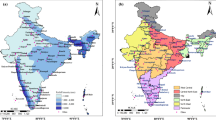Abstract
Time series of streamflow plays an important role in planning, design and management of water resources system. In the event of non availability of a long series of historical streamflow record, generation of the data series is of utmost importance. Although a number of models exist, they may not always produce satisfactory result in respect of statistics of the historical data. In such event, artificial neural network (ANN) model can be a potential alternative to the conventional models. Streamflow series, which is a stochastic phenomenon, can be suitably modeled by ANN for its strong capability to perform non-linear mapping. An ANN model developed for generating synthetic streamflow series of the Pagladia River, a major north bank tributary of the river Brahmaputra, is presented in this paper along with its comparison with other existing models. The comparison carried out in respect of five different statistics of the historical data and synthetically generated data has shown that among the different models, viz., autoregressive moving average (ARMA) model, Thomas-Fiering model and ANN model, the ANN based model has performed better in generating synthetic streamflow series for the Pagladia River.
Similar content being viewed by others
References
1 Ahmed JA (2004) Development of optimal operating policy for Pagladia multipurpose reservoir. Ph.D. Dissertation, India Institute of Technology Guwahati, India
2 Akaike H (1978) On the likelihood of a time series model. Statistician 27(3–4):217–236
3 Braga BPF, Yeh WW-G, Becker L, Barros TL (1991) Stochastic optimization of multiple reservoir system operation. J Water Resour Plan Manage ASCE 117(4):471–481
4 Brahmaputra Board, Government of India (1997) Detail project report for Pagladia multipurpose reservoir
5 Box GEP, Jenkins GM (1976) Time series analysis: forecasting and control. Holden-Day, San Francisco, Calif
6 Burian JS, Durrans SR, Nix SJ, Pitt RE (2001) Training artificial neural networks to perform rainfall disaggregation. J Hydrol Engg ASCE 6(1):43–51
7 Chandramouli V, Raman H (2001) Multireservoir modeling with dynamic programming and neural networks. J Water Resour Plan Manage ASCE 127(2):89–98
8 Das G (2000) Hydrology and soil conservation engineering. Prentice Hall of India, New Delhi
9 Hagan MT, Demuth HB, Beale M (1996) Neural network design. PWS/KENT Publishing Co., Boston
10 Hipel KW, McLeod AI, Lennox WC (1977) Advances in Box-Jenkins modeling. 1. Model construction. Water Resour Res 13(3):567–576
11 Karunanithi N, Grenney WJ, Whitley D, Bovee K (1994) Neural networks for river flow prediction. J Comput Civ Engg ASCE 8(2):201–220
12 Ljung GM, Box GEP (1978) On a measure of lack of fit in time series models. Biometrika 65:297–303
13 Loucks DP, Stedinger JR, Haith DA (1981) Water resources system planning and analysis. Prentice Hall, Englewood Cliffs, New Jersey
14 Maass A, Hufschmidt MM, Dorfman Jr R, Thomas HA, Marglin SA, Fair GM (1970) Design of water resources systems. Harvard University Press, Cambridge
15 Ochoa-Riveria JC, Garcia-bartual R, Andreu J (2002) Multivariate synthetic streamflow generation using a hybrid model based on artificial neural networks. Hydrol Earth Syst Sci 6(4):641–654
16 Raman H, Sunilkumar N (1995) Multivariate modeling of water resources time series using artificial neural networks. Hydrol Sci J 40:145–163
17 Rumelhart DE, Hinton GE, Williams RJ (1986) Learning internal representations by error propagation. Parallel distributed processing, vol. 1. MIT Press, Cambridge, Mass, pp 318–362
18 Sarma AK, Ahmed JA (2002) Stochastic model for synthetic streamflow generation. Paper presented in the International conference Recent Trends in Probability and Statistics: Theory and Applications, 29–31st December 2002
19 Sarma AK, Ahmed JA (2004) Stochastic model for synthetic stream-flow generation. statistical thinking: method and application. Capital Publishing Co., pp 253–258
20 Stedinger JR, Taylor MR (1982) Synthetic streamflow generation 1. Model verification and validation. Water Resour Res 18(4):909–918
21 Thomas HA, Fiering MB (1962) Mathematical synthesis of streamflow sequences for the analysis of river basins by simulation. In: Maass A, Humfschmidt MM, Dorfman R, Thomas Jr HA, Marglin SA, Fair GM (eds) Design of water resource systems. Harvard University Press, Cambridge, Mass
22 Zurada JM (1999) Introduction to artificial neural systems. West Publishing co., St. Paul, Minn
Author information
Authors and Affiliations
Corresponding author
Rights and permissions
About this article
Cite this article
Ahmed, J.A., Sarma, A.K. Artificial neural network model for synthetic streamflow generation. Water Resour Manage 21, 1015–1029 (2007). https://doi.org/10.1007/s11269-006-9070-y
Received:
Accepted:
Published:
Issue Date:
DOI: https://doi.org/10.1007/s11269-006-9070-y




